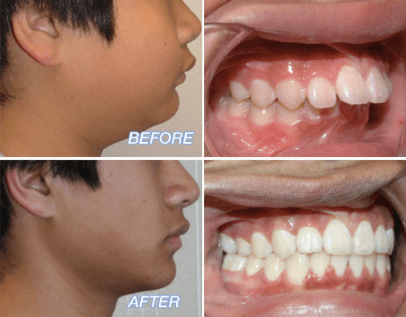Overjet Definition
An Overjet is the overlap of the teeth in the horizontal dimension. This means that the top teeth protrude over the bottom ones. It’s often called ‘overbite’ although this is not the correct term and an orthodontist would always use the term, overjet. An overjet in adults can be corrected by getting braces treatment. Your Smileworks orthodontist will be able to advise you on the best course when you come for your braces assessment. An overjet is different from an overbite. For more information, click the link to see our overbite article.
A patient’s overjet is a measurement of how far (in mm) their top teeth protrude over their bottom ones in the anterior-posterior plane. So you might hear your dentist say something like, “you have an 8mm overjet”.
The normal amount of overlap is between 2 and 4mm. It is from the overjet that the relationship of the incisors (or BSI classification) is determined as Class 1, 2 or 3. Class 1 is the ideal, where the upper teeth protrude by 2-4mm over the lower in both the horizontal and vertical, and the lower teeth contact the palatal (rear) surface of the upper teeth when the jaws are together.
Class 2 incisal relationships have an increased value, where the upper front teeth protrude more, and Class 3 incisal relationships are where the lower teeth are more protrusive than the upper (a so-called underbite).
What causes an Overjet?
An increase in Overjet can be caused by a number of different factors. Most commonly, it is where the upper jaw is further forward in relation to the lower jaw, and the teeth on the upper are therefore shifted forwards in a so-called skeletal discrepancy. This can either be caused by a more prominent maxilla (upper jaw) or a retruded mandible (lower jaw further back than it should be). This causes a discrepancy in how all teeth contact, and can manifest as an increased overjet.
An increased overjet can also be caused by a discrepancy in the number of teeth, or the length of the arch. If the lower jaw is missing teeth, whether congenitally or as a result of premature loss of teeth, this can also increase the amount that the upper teeth protrude over the lower.
Finally, increased inclination of the upper teeth can result in increased overjet. This may be due to thumb- or digit-sucking habits, or simply because the teeth came through in this way and the overjet is in turn increased.
Aesthetic problems
Teeth that stick out are unaesthetic. They are often called “goofy” and patients may find they lack confidence or do not smile on photos, straining to cover the teeth with the lips.
Clinical problems
Increased overjet can cause an increased susceptibility to dental trauma. With an overjet of over 4mm, patients are estimated to have double the risk of incisor trauma, which can in turn lead to premature loss of the teeth.
Severe increases in overjet can result in problems with speech and mastication (chewing). In patients where the teeth protrude so much that they have difficulty closing their lips around them, the mouth may become dry as a result and thus increase the risk of tooth decay as saliva protects the teeth from this to a certain extent.
Solutions / systems
If the overjet is increased, braces can be used to align the teeth and reduce it. If the teeth protrude significantly or there is increased crowding, this may require braces in combination with selective extraction of teeth on the upper arch (or both arches).
Bringing the teeth into occlusion despite a discrepancy where the upper arch of teeth are further forwards is known as orthodontic camouflaging, and is achieved by the removal of one pair of teeth on the upper row, usually the first or second premolars in the middle of the arch.
This means that the upper teeth can be retracted into the space and the discrepancy can be compensated for by eliminating the space that the extracted teeth have made.
In more severe cases, it may not be an option to simply align the teeth and camouflage the skeletal discrepancy orthodontically. In cases where the discrepancy is large and of a bony nature (maxilla too far forward or mandible too far back), jaw surgery may be required in order to achieve an improvement in the function and aesthetics for the patient.
For more information about getting braces at Smileworks follow the link here to Braces.
Alternatively if you’d like to learn more, follow the links here to our overcrowding in adults and deep overbite articles.
[google-reviews-pro place_name=’Smileworks Liverpool’ place_id=ChIJYcxahCghe0gRzAq3iKInT8E auto_load=true rating_snippet=true min_filter=5 disable_user_link=true view_mode=slider slider_speed=3 slider_count=4 open_link=true]

